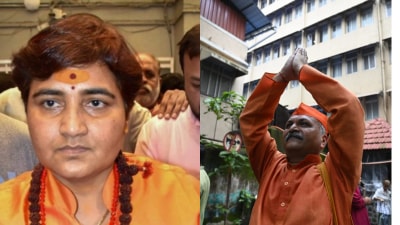First commercial flight lands, Navi Mumbai airport likely to be inaugurated on April 17
Earlier, Navi Mumbai International Airport Private Limited was seeking a vendor to supply aviation turbine fuel (JET A-1) for testing purposes at the upcoming airport.
 The aircraft was welcomed with the traditional water salute by two Crash Fire Tenders (CFT) of NMIA. (Express)
The aircraft was welcomed with the traditional water salute by two Crash Fire Tenders (CFT) of NMIA. (Express)The much-awaited Navi Mumbai International Airport (NMIA) is set to be inaugurated on April 17, marking a significant step in addressing the air travel demand of the Mumbai Metropolitan Region (MMR).
The announcement came after the airport had its first commercial aircraft landing on Sunday, with an Indigo A320 passenger aircraft that took off from the Mumbai airport landed successfully on its new 08/26 runway at 1.32 pm.
“We have set the target of April 17 for the inauguration of NMIA. This comes 70 days after getting the AOP (Air Operator Permit) which we are supposed to get on February 6,”Adani Airport Holdings Ltd CEO Arun Bansal told media after the successful trial landing of the first civil passenger aircraft, paving the way for securing an aerodrome licence to start commercial operations.
The aircraft was welcomed with the traditional water salute by two Crash Fire Tenders (CFT) of NMIA.
“This is a momentous day for Navi Mumbai International Airport. The successful completion of the validation flight is a major milestone, and we are now one step closer to operationalising the airport, prioritising safety at every step,” said Bansal.

The successful landing came weeks after the Airports Authority of India (AAI) validated the Precision Approach Path Indicator (PAPI) system at NMIA. The PAPI system, important for guiding pilots during landings, was rigorously tested under day-and-night conditions to ensure operational safety.
Earlier, Navi Mumbai International Airport Private Limited was seeking a vendor to supply aviation turbine fuel (JET A-1) for testing purposes at the upcoming airport. It had issued a request for proposal to invite bids from vendors authorised by the Government of India and the Directorate General of Civil Aviation (DGCA) to distribute and sell aviation turbine fuel in the country.
The selected vendor will play a crucial role in supporting the airport’s operational readiness by providing fuel for essential testing at the airport’s fuel farm.
In October, an Indian Air Force (IAF) C-295 aircraft successfully landed on the south runway, demonstrating the airport’s ability to handle diverse types of aircraft, testing the runway, taxiways, air traffic control systems and overall handling procedures.
Largest greenfield airport
The NMIA, which began construction in August 2021, is expected to be operational by early 2025. Once completed, it will become one of the largest greenfield international airports in the country, with a capacity to handle 60 million passengers and 1.5 million tonnes of cargo annually, as outlined in its Concession Agreement.
Spread across 1,160 hectares, NMIA will initially operate Terminal 1, which can handle 20 million passengers annually. Terminal 2, planned for future phases, will add capacity for another 30 million passengers per year. It will feature two parallel runways, capable of simultaneous and independent aircraft operations, and three passenger terminals, in addition to state-of-the-art infrastructure.
Phase 2 of NMIA is set to begin in July next year, with designs already underway. This phase will further expand the airport’s infrastructure and operational capacity, reinforcing its role as a key aviation hub.
Speaking about the second terminal, Bansal said, “The design works for the second terminal has already started and the construction is slated to begin by June or July next year.”
A separate cargo terminal is also part of the project, designed to handle up to 2.6 million tonnes of cargo annually.
“By 2029, NMIA is expected to accommodate 50 million passengers annually with both terminals operational,” added Bansal. The infrastructure includes two parallel runways, full-length taxiways, and parking facilities for 350 aircraft.

Developed at a cost of Rs 18,000 crore, NMIA is a public-private partnership between Adani Airports Holdings Limited and CIDCO. The airport is named after Dinkar Balu Patil, a late activist and former MP who played a pivotal role in advocating for the rights of local communities during land acquisition protests in the 1970s and 1980s.
Speaking during the landing event, Vijay Singhal, managing director of CIDCO, said, “This milestone highlights the airport’s capability to facilitate safe operations and represents a significant leap toward its operationalisation.”
After its April inauguration, NMIA will begin domestic operations by the end of May 2025. International operations are slated to commence by the end of July, following regulatory approvals, including licensing from the Directorate General of Civil Aviation (DGCA). The airport’s readiness includes securing verification and DGCA certifications, essential for ensuring safety and operational compliance.
The airport’s development aligns with broader goals to enhance connectivity and alleviate congestion at Mumbai’s Chhatrapati Shivaji Maharaj International Airport, which handled 52.8 million passengers in this fiscal starting from April.
Economic and regional growth
Residents of Navi Mumbai and neighbouring regions have long awaited the airport’s operationalisation. NMIA is expected to boost the local economy, generate employment, and strengthen global connectivity. “NMIA is not just an airport; it is an economic enabler for the region. It will significantly enhance connectivity and create numerous opportunities for growth,” added Singhal.
The new airport will function alongside CSMIA as part of an urban-dual airport system, significantly enhancing capacity for passengers and cargo operators. Plans are underway to establish seamless connectivity between the two airports through integrated road networks and Metro services, further improving accessibility and efficiency in the Mumbai Metropolitan Region.
“The airport is a testament of regional development and modern infrastructure. We are ensuring that it is well connected with every part of the MMR and there is absolute ease for the passengers by every means,” Singhal added.












